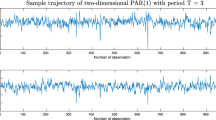Abstract
The stability of time-varying autoregressive (TVAR) models is an important issue in many applications such as time-varying spectral estimation, EEG simulation and analysis, and time-varying linear prediction coding (TVLPC). For stationary AR models there are methods that guarantee stability, but the for nonadaptive time-varying approaches there are no such methods. On the other hand, in some situations, such as in EEG analysis, the models that temporarily exhibit roots with almost unit moduli are difficult to use. Thus we may need a tighter stability condition such as stability with margin 1−ϱ. In this paper we propose a method for the estimation of TVAR models that guarantees stability with margin 1−ϱ, that is, the moduli of the roots of the time-varying characteristic polynomial are less than or equal to some arbitrary positive number ϱ for every time instant. The model class is the Subba Rao-Liporace class, in which the time-varying coefficients are constrained to a subspace of the coefficient time evolutions. The method is based on sequential linearization of the associated nonlinear constraints and the subsequent use of a Gauss-Newton-type algorithm. The method is also applied to a simulated autoregressive process.
Similar content being viewed by others
References
M. Boudaoud and L. Chaparro, Composite modeling of nonstationary signals,J. Franklin Inst., 324:113–124, 1987.
J. Chang and J. R. Glover, The feedback adaptive line enhancer: A constrained IIR adaptive filter,IEEE Trans. Signal Process., 41:3161–3166, 1993.
S. N. Elaydi,An Introduction to Difference Equations, Springer-Verlag, Berlin and New York, 1996.
W. Gersch, A. Gevins, and G. Kitagawa, A multivariate time-varying autoregressive modeling of nonstationary covariance time series, inIEEE CDC-83, pp. 579–584, 1983.
Y. Grenier, Time-dependent ARMA modeling of nonstationary signals,IEEE Trans. Acoust. Speech Signal Process., ASSP-31:899–911, 1983.
M. Hall, A. Oppenheimer, and A. Willsky, Time-varying parametric modeling of speech,Signal Process., 5:267–285, 1983.
M. Juntunen, J. Tervo, and J.P. Kaipio, Stabilization of stationary and time-varying autoregressive models, inIEEE ICASSP98, pp. 2173–2176, 1998.
M. Juntunen, J. Tervo, and J. P. Kaipio, Root modulus constraints in autoregressive model estimation.Circuits Systems Signal Process., 17:709–718, 1998.
E. I. Jury,Theory and applications of Z-transform method, Krieger, Huntington, New York, 1973.
J. P. Kaipio, Simulation and estimation of nonstationary EEG, Ph. D. thesis, University of Kuopio, Finland, 1996.
J. P. Kaipio and P. A. Karjalainen, Simulation of nonstationary EEG,Biol Cybern., 76:349–356, 1997.
E. W. Kamen, P. P. Khargonekar, and K. R. Poolla, A transfer-function approach to linear time-varying discrete-time systems,SIAM J. Control Optim., 23:550–565, 1985.
F. Kozin and F. Nakajima, The order determination problem for linear time-varying AR models,IEEE Trans. Automat. Control, AC-25:250–257, 1980.
C. L. Lawson and R. J. Hanson,Solving Least Squares Problems, SIAM, Philadelphia, 1995.
L. A. Liporace, Linear estimation of nonstationary signals,J. Acoust. Soc. Amer., 58: 1288–1295, 1975.
G. Ludyk,Stability of Time-Variant Discrete-Time Systems, vol. 5 ofAdvances in Control Systems and Signal Processing, Vieweg, Braunschweig, 1985.
S. L. Marple,Digital Spectral Analysis with Applications, Prentice-Hall, Englewood Cliffs, NJ, 1987.
G. Martinelli, G. Orlandi, L. Prina Ricotti, and S. Ragazzini, Identification of stable nonstationary lattice predictors by linear programming,Proc. IEEE, 74:759–760, 1986.
A. Nehorai and D. Starer, Adaptive pole estimation,IEEE Trans. Acoust. Speech Signal Process., 38:825–838, 1990.
J. J. Rajan, Time series classification, Ph.D. thesis, University of Cambridge, Cambridge, England, 1994.
T. Subba Rao, The fitting of non-stationary time series models with time-dependent parameters,J. Roy. Statist. Soc., Ser. B 32:312–322, 1970.
B. L. Van der Waerden,Algebra I, Frederik Ungar, 1970.
Author information
Authors and Affiliations
Rights and permissions
About this article
Cite this article
Juntunen, M., Tervo, J. & Kaipio, J.P. Stabilization of Subba Rao-Liporace models. Circuits Systems and Signal Process 18, 395–406 (1999). https://doi.org/10.1007/BF01200790
Received:
Revised:
Issue Date:
DOI: https://doi.org/10.1007/BF01200790




